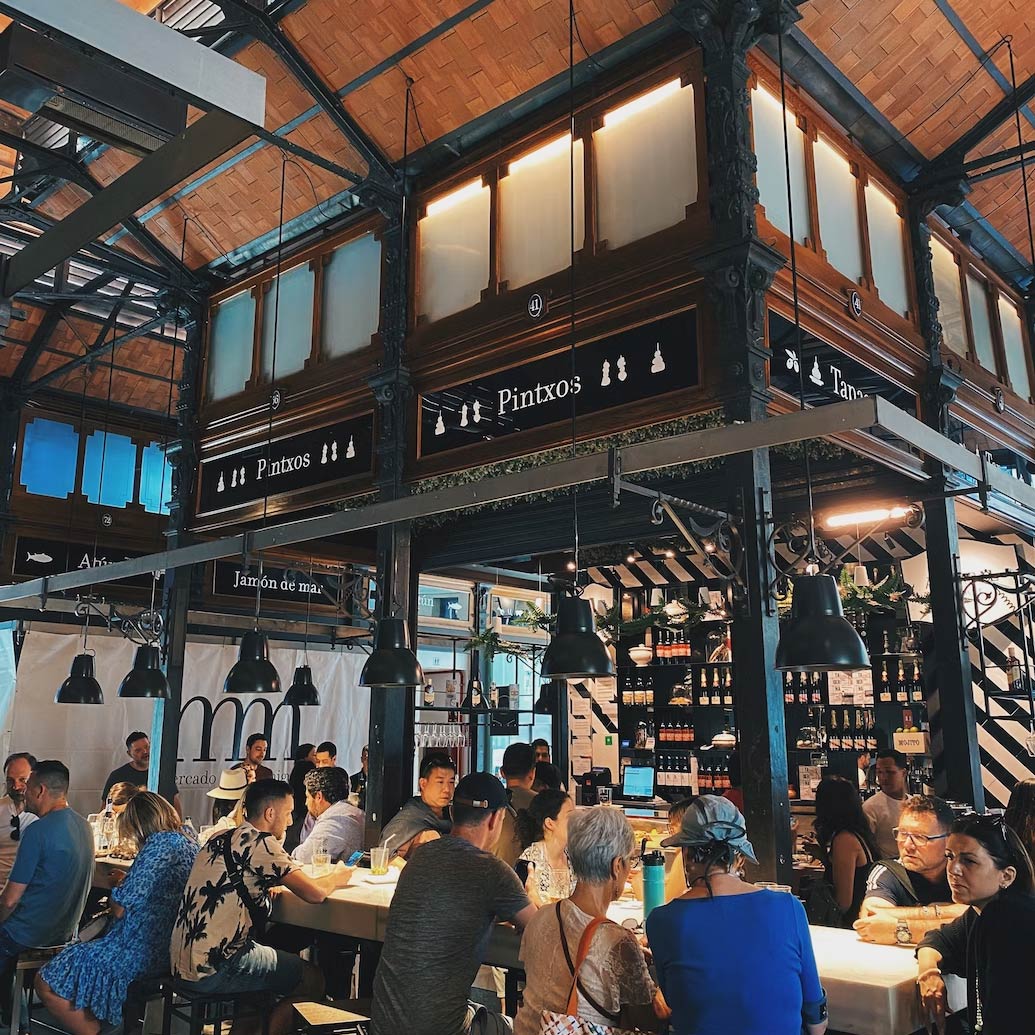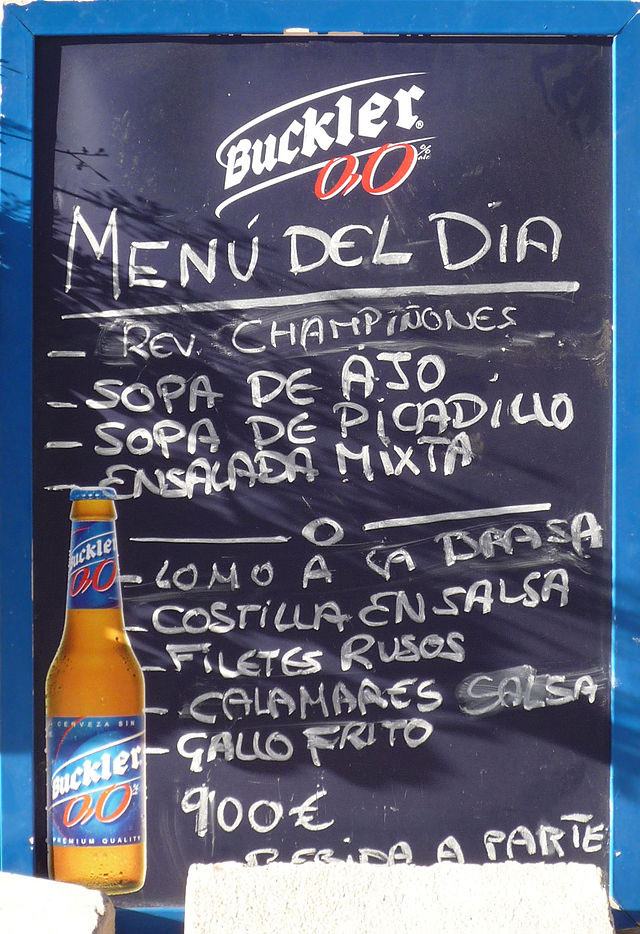Common mistakes in Spanish
This is a custom heading element.
Everyone makes mistakes, and that’s part of the fun of learning a language too! But why fun? Well, given that the only way to improve in any language is by speaking as much as possible, you’re bound to get things wrong and sometimes these mistakes can give rise to some hilarious situations. Native Spanish speakers will always valorar (appreciate) your efforts to talk to them in their language, and will help you to get better. However, if we can evitar (avoid) some of these typical mistakes, then you’ll be able to make yourself understood much more quickly.
1. “Estoy embarazada” doesn’t mean “I’m embarrassed”
This is a very common error and one that we need to sort out right away! In Spanish, estar embarazada means to be pregnant, so if you’re a woman and say this then you’ll probably get a response of “felicidades” or “enhorabuena” which mean “congratulations”. A man making this mistake will probably get some very confused looks! The right way to say “I’m embarrassed” in Spanish is “Me da vergüenza”.
2. Lots of phrases that use to be in English use a different verb in Spanish
When you’re trying to learn Spanish, it’s important to remember that you can’t simply traducer (translate) everything word for word from English. This can get you into all sorts of problems, such as the one in our first common mistake! Let’s look at some examples with their correct translations and a literal version in English so you can see the differences.
| English | Incorrect Spanish | Correct Spanish | Literal translation |
| I am 20 | Soy 20 (this doesn’t mean anything) | Tengo 20 años | I have 20 years |
| I’m too hot! | Estoy demasiado caliente (which means ready for some loving!) | Tengo demasiado calor | I have too much heat |
| Let’s have a drink | Tenemos una bebida (which means we have a drink in our possession) | Tomamos algo | Let’s take something |
There are plenty more of these so try to learn these as expressions so that you can get your message across more clearly.
3. Using the verb “gustar” incorrectly
“Gustar” means “to like” but in Spanish we need to say that something is likeable to you, not that you like it. Normally, an –ar verb in the present is conjugated as verb without ar + o (i.e Hablo – I speak). However, this verb is reflexive and works differently. Let me show you an example:
- Me gusta la nueva serie – I like the new series (The series is likeable to me) – Don’t say Gusto la nueva serie.
- Me gustan las manzanas – I like apples (Apples are likeable to me) – Don’t say Gusto las manzanas.
Another issue with this verb is when you’re talking about liking people. If you follow the rule above, you’d probably say Me gusta Pablo to mean I like Pablo. This, however, means you find Pablo romantically attractive! Now, that might be the case, but if you mean I like Pablo as he’s a nice person then we have to say Pablo me cae bien. It’s funny that a lot of these mistakes revolve around unintended romantic encounters, right?
4. Some words in English which are plural or countable are not in Spanish, and vice versa
Although we do have other blogposts about the topic of singular and plurals, it’s a good idea to remind you again about some common differences with plurals and countable/uncountable nouns from English to Spanish. Here are just a few examples:
| English to wrong Spanish | Correct Spanish and literal translation |
| People are – Las gentes son | La gente es – People is |
| The news is depressing – Las noticias es deprimente | Las noticias son deprimentes – The news are depressing |
| A piece of furniture – Una pieza de mueble | Un mueble – a furniture |
| Some advice – Algunos consejo | Un consejo – an advice |
See what we mean? When listening to and reading Spanish, try to apuntar (make a note) of examples like these so you can avoid them when speaking and writing.
5. Articles a/the are used differently in Spanish
This is a big area, and one which you’ll need time to get used to. In Spanish, it’s much more common to use the articles for the, and sometimes they don’t use a/an where you would in English. Again, it’s probably easier just to show you a few times when this is the case.
| English | Spanish |
| I’m a teacher | Soy un profesor |
| Marta loves chocolate | A Marta le encanta el chocolate |
| They climbed Mount Everest | Escalaron el Monte Everest OR el Everest |
| Cats are more intelligent than dogs | Los gatos son más intelligentes que los perros |
Hopefully, now you’re more consciente (aware) of these typical errors, you’ll be better able to correct yourself when speaking Spanish. Having said that, even if you do say something wrongly, it’s simply a chance to be corrected and learn the right way to say things. You should never tener miedo (be afraid) of mistakes!
Here at Hablamos, we’re waiting to help you lose your fear of speaking and correct your mistakes so you can feel more confident when out and about in the Spanish-speaking world. Hablamos - full-on Spanish!
Using Gustar and other similar structures
This is a custom heading element.
If someone said to you “Chocolate is pleasing to me” you might be forgiven for thinking they’d just stepped off the set of a period drama! However, when speaking Spanish that’s exactly what you need to say when you want to express that you like chocolate. We would say me gusta el chocolate using the verb gustar which literally means to be pleasing to.
Firstly, let’s look at some basic patterns. When we are talking about singular nouns, we’d use me gusta for I like and with plural nouns we need to say me gustan to mean the same thing. This is because gustar has to agree with the sustantivo (noun) we are talking about. Look at the following table to see how this works in practice and with people other than “I”.
| Singular | English | Plural | English |
| Me gusta el chocolate | I like chocolate | Me gustan los perros | I like dogs |
| Te gusta el chocolate | You (informal) like chocolate | Te gustan los perros | You (informal) like dogs |
| Le gusta el chocolate | He/She/You (formal) like(s) chocolate | Le gustan los perros | He/She/You (formal) like(s) dogs |
| Nos gusta el chocolate | We like chocolate | Nos gustan los perros | We like dogs |
| Nos gusta el chocolate | We like chocolate | Nos gustan los perros | We like dogs |
| Os gusta el chocolate | You (plural) like chocolate | Os gustan los perros | You (plural) like dogs |
| Les gusta el chocolate | You (formal plural)/They like chocolate | Les gustan los perros | You (formal plural)/They like dogs |
Can you spot the pattern? You simply add an “n” to gusta when we are talking about plural nouns, and the person changes using the indirect object pronouns in the table. The translations we’ve given in English are the meaning of the Spanish phrases, but not a literal translation.
However, if you’ve already started learning Spanish, or you’ve read some of our other grammar blogs, you might be wondering why the verb gustar doesn’t change its ending depending on the person who you’re talking about. That’s because, as mentioned before, the subject of the verb is the thing which is liked and not the person saying the phrase.
How can we say “I like you”
So far, we’ve just seen how to use gustar to talk about liking objects or things like animals. But how can we say “I like you” for example? Here’s where we need to tener cuidado (be careful) as you could end up saying you fancy someone, rather than liking them as a friend! For, “I like you in a romantic way” you’d follow the normal verb patterns and say Me gustas (You are pleasing to me). To say “I like you in a platonic way” you need to use the verb caer bien and say Me caes bien (You sit well with me). This verb caer bien/mal also works in a similar way to gustar and you can follow the same rules as in the table above to use it to talk about liking people (or not!) as friends. Here are a couple of examples:
- A José le cae bien Roberto – José likes Roberto
- A mí me caen bien mis suegros – I like my mother- and father-in-law
- Nos cae mal el nuevo compañero de piso – We don’t like our new flatmate
- Les cae mal el jefe – They don’t like their boss
Easy! Now you’ve learnt how to use both gustar and caer bien/mal to be able to talk about liking people and things. This same structure is also used with a range of other verbs in Spanish. Let’s take a look at some.
Other verbs, same structure
| Verb | Example | English |
| Aburrir (to bore) | Nos aburre el profesor | We find the teacher boring |
| Doler (to hurt) | Me duelen los pies | My feet hurt |
| Encantar (to love) | A Juana le encanta esquiar | Juana loves skiing |
| Fascinar (to fascinate) | Os fascinan las películas de terror | You’re fascinated by horror films/You love horror films |
| Interesar (to interest) | A los niños no les interesa ir a museos | The children aren’t interested in going to museums |
| Preocupar (to worry) | Les preocupa la salud de su madre | They are worried about their mum’s health |
In order to get better at using this sort of verb structure, you need to be speaking Spanish as much as possible so in the end you’ll naturally use these different types of verbs. By practising your Spanish with native speakers, you’ll get plenty of chances to be corrected and listen to more examples of accurate usage of this grammar point. As with everything when learning Spanish, you need to be exposed to as much of the language as possible.
Why not come and join one of our online or face-to-face Spanish courses so you can learn how to use the verb “gustar” more accurately and with greater confidence?
You’ll soon be chatting away talking about your likes and dislikes in no time!
Hablamos - full-on Spanish!
Driving in Madrid
This is a custom heading element.
Many people believe that how somebody drives not only tells us a lot about them, but also about the culture they come from: “Show me how you drive and I’ll tell you who you are.” Now I don’t know how true that is because I know people who are sweet and mild mannered only to transform into a rage-filled, profanity spluttering demons the moment someone overtakes them on the road. Ha ha!
However, there is some truth to the stereotypes of driving in different countries and Spain and Madrid is no exception. So, what is it like driving round the Spanish capital? Penned in on all sides by commuters and tourists vying for a spot on the road and making quite a racket whilst doing it, Madrid is a definite driving experience, to say the least.
But what sets a Spanish driver apart from other nationalities?
What makes them tick? And how can you blend seamlessly into their busy roads without receiving a barrage of swearwords and curses and looking like a guiri (foreigner)? Contrary to what you might hear from certain tourists and expats, the Spanish are, in fact, not the worst drivers in Europe and actually far from it (this writer would personally like to give that award to the Italians ☺). But, in my experience what really defines a Spanish driver is the noise they make!
Spanish roads are a cacophony of horns, shouts, bangs and crashes. In fact, a recent European union survey of bad driving habits in Europe stated that 60% of Spaniards use their horn every day in the car compared to just 5% of British drivers. Now as a conservative and polite driver, you may well be wondering “what on earth could they be using the horn for so often?” Well the short answer is ……everything. The Spanish will use the horn to tell other drivers that the light has changed and they have taken 3 seconds longer than they should before moving. It can be used as a warning, as a greeting, as a friendly reminder that you left your lights on. The point is, if you are going to be driving in Spain and Madrid you need to become accustomed to that sound above all else. In the UK for example the horn is a seldom heard sound that is usually used in extreme circumstances, which can in turn lead to a sensation of PTSD when driving in Spain.
While manners don’t necessarily make someone a good driver, it is fair to say that good manners make driving a more pleasant experience. Manners in Madrid however, are not very easily found. If you are used to a kind wave of thanks or a flash of lights when you let someone merge or join your lane in traffic, you may find it sorely missing here. Likewise, a pedestrian won’t give you a second glance after you let them cross the street. On the contrary, be ready for someone to double park in front of your car and then abandon their own vehicle for as long as it takes them to buy something or run their errand. The flip side of this is that if they block in another Spaniard, that person won’t hesitate to return to their old friend the horn and blast it repeatedly for as long as it takes for the other person to come and move their car (often without embarrassment or shame). No matter what is around them a hospital, a school or sleeping children, the noise will carry on at all times of day until they are freed from their parking prison.
Other differences about driving in Spain
Another big difference between Spain and many other countries is how Spanish drivers park their cars. In the UK, it is drilled into you by your driving instructor that to touch another car is the ultimate sin and of course will result in immediate failure in your test. This means that the art of parking is honed to the point where you can do it blindfolded and still leave a respectable amount of space for other drivers to easily manoeuvre out. The Spanish, on the other hand, appear to have no such care for the cars of others. In fact, they have perfected an art of parking that they call “parking with kisses” where they wantonly hit the bumper of the cars in front and behind to help them navigate the parking process. If someone has parked too close, which they always do, no problem! Just reverse into the car and gently hit their bumper and then pull away, guilt free.
I have to admit that I always disliked the British worship of their cars. It is an odd thing to love and give so much reverence to. The Spanish on the other hand will happily sit on other peoples bonnets, drink a beer, have a smoke, and catch up with old friends.
Driving in the city itself shows Madrid to be a network of one way streets and narrow old roads mixed elegantly with sprawling 6 lane rotondas (roundabouts) and like most capitals the residents dart in and out of lane incredibly close and with very little indication. Also, with the new Madrid Central restrictions, you can easily be fined for driving in a restricted area without even being aware of it! So, perhaps on reflection, we would recommend leaving your car in your overpriced rented garage spot and just walking or taking the very good and economical public Madrid transport when you come to your Spanish class at Hablamos Spanish School. ☺
Useful Driving Vocabulary
En la calle:
Rotonda/Glorieta – roundabout
Carril – traffic lane
Semáforos – traffic lights
Paso de cebra – zebra crossing
Parquímetro – parking meter
Línea continua – solid line
Peatón – pedestrian
Partes del coche:
Intermitente – indicator
Claxon – horn
Volante – steering wheel
Freno – brake
Espejo – mirror
Marchas – gears
Maletero – boot /trunk
Motor – engine
Cinturón de seguridad – seat belt
Parabrisas – windscreen
Tener carnet de conducir – have a driving licence
Aprobar el examen de conducir – pass your driving test
Clase de conducir – driving lessons
우리는 말한다 - full-on Spanish! ☺
Tener or Haber – Which one should you use?
This is a custom heading element.
Once you start learning Spanish, you’ll soon come across both of these important verbs – tener and haber. Both of them, more or less, equate to the verb to have in English, but they aren’t interchangeable and have different uses. Let’s dive in and have a look at why and when we need to use these two words.
What’s the difference?
So, the answer to this question is fairly simple but you might need some examples to fully pillarlo (get it). In simple terms, tener is the verb to have when used as the main verb in a sentence and means possession or owning. On the other hand, haber is an auxiliary verb which we have to use when forming various verb tenses in Spanish. Have a look at these sentences to see if you can spot the difference.
| Haber | Tener |
| He comido una manzana esta mañana – I have eaten an apple this morning | Tengo dos perros y un gato – I have two dogs and a cat |
| Habían practicado mucho para presentar una obra perfecta – They had practised a lot to be able to put on a great show | Me dijeron que tienen mucho trabajo que hacer estos días – They told me they have a lot of work to do at the moment |
In the table above you have an example of haber in the present perfect and the past perfect where it simply acts as the auxiliary for the main verb. The two examples of tener show you that the animals and the work are owned/possessed by someone.
Other uses of tener
Apart from the basics we’ve spoken about already, there are specific things which we need to use tener for in Spanish.
- To talk about someone’s age
- Tengo 16 años – I am 16
- To express “have to + verb” as in obligation
- Tenemos que estudiar para el examen – We have to study for the exam
- Tiene que ser más comprensivo – He has to be more understanding
- Tienen que limpiar la casa – They have to clean the house
- To talk about emotions, feelings and certain states
- Tenemos demasiado frío – We are too cold
- Tenías razón – You were right
- ¿Tenéis sed? – Are you thirsty?
- Tenía sueño – He was tired
- In some idiomatic expressions
- Tener lugar – To take place
- Tener ganas de – To want to do something
- Tener cariño – To be fond of
- Tener cuidado – To be careful
As you can see in the English translations, a lot of these phrases are expressed with the verb to be in English. This is often confusing for learners of Spanish so try to start learning expressions rather than translating everything word-for-word.
Other uses of haber
Just like with our other verb, haber has a particular set of uses which we’ll look at below.
- To translate the structure “there is/are”
- Hay tres personas en la sala – There are three people in the room
- Había unos soldados en la calle – There were some soldiers in the Street
- No hay tiempo para ir al parque – There’s no time to go to the park
- ¿Hay algún museo por aquí? – Is there a museum around here?
- To talk about things you need to do with “haber + que + verb”
- Hay que comprar papel higiénico – It’s necessary to buy toilet paper/We need to buy toilet paper
- Mañana hay que terminar el proyecto – It’s necessary to finish the project tomorrow/We need to finish the project tomorrow
- To talk about events which occurred in the past or future
- Hubo un accidente en la autopista – There was an accident on the motorway
- Va a haber un festival en el pueblo el fin de semana que viene – There’s going to be a festival in the town next weekend
Hopefully this quick guide to tener and haber will help you when speaking Spanish to be able to select the right verb to use. A good way to learn the differences is to read and listen to as much Spanish as possible so you see lots of ejemplos (examples).
Your profe (teacher) here at 우리는 말한다 will help you better understand all of the points above and you’ll be able to practise with people from all around the world. Hablamos - full-on Spanish!
How to order a coffee in Spanish
This is a custom heading element.
I don’t know about you, but when I think of having a drink in Spain, I think about a nice refreshing caña (small beer) or an even more refreshing doble (bigger beer) and of course the copious amounts of excellent cheap wine which flows like water. At a stretch, I would also say I think of large copas (spirit mixers) and chupitos (shots).
However, it is fair to say I do not associate Spain with warm beverages. Far from it!. But how wrong I was! For you see café (coffee) in Spain is just as important as any of the drinks mentioned above. So I thought to myself, maybe our students studying Spanish here at Hablamos Spanish Schools in Madrid need an inside look at the right mezcla (blend) of language to help navigate the varieties of coffee on offer in the cafeterías (cafes) and bars.
So, let’s start with the basics, the most common coffee that you can pick up in Spain and the one that most locals drink. It was uniquely described by the former mayor of Madrid, Ana Botella, in Madrid’s Olympic bid as “a relaxing cup of café con leche (coffee with milk)” Café con leche is a staple of Spain life and by far the most popular choice all over the country. It is as simple as it sounds but you will be asked how you want your leche (milk), caliente (hot) or templada (warm). What you will get is a no-nonsense shot of espresso with some milk no foam, no chocolate on top, just the basics! Even in places like Starbucks where café con leche isn’t on the menu, you can go in and ask for it and everyone knows what it is.
Cómo pedir un café
There are of course some variations on the basic café con leche. You are also able to order a café cortado (literally a cut coffee) which is the same but with far less milk. Think of an espresso with just a dash of milk. Not to be confused with a manchado (stained) which is milk with just a drop of café.
Of course, if you like a black watery coffee you can just ask for un Americano. It is typically a weaker option and maybe good if you are concerned about being up toda la noche (all night). Generally in Madrid, you can pick up other typical favourites like a Cappuccino or Latte with varying levels of quality.
Another variation could be a descafeinado – a decaf. And this could also bring a question from the waiter (camarero) of: “¿De máquina o de sobre?, meaning, a packet of Nescafé or coffee from the coffee pot.
They may also ask how you would like your coffee to be served: ¿en vaso o taza? and what size: ¿en taza grande de desayuno o mediano? (in a biger breakfast style cup or a medium one).
If you are feeling more adventurous and want something to cool off on a hot summer’s day, why not try ordering a typical Spanish café con hielo (coffee with ice), which is exactly as it is described. Usually, a double espresso is poured over ice to give your caffeine hit a cooler more refreshing appeal. You can even ask for a little milk in this too.
Finally, if you are looking for something a little stronger that might counteract the caffeine you could always try a carajillo (coffee with a shot of liquor). Depending on where you are, the type of liquor could vary. However, here in Spain, the typical thing to have with your coffee is brandy. That being said, you can also ask for a café irlandés (a coffee with whisky).
Much more than coffee
Coffee is ubiquitous in Spain – everybody drinks it, much more than the typical British tea. Spaniards don’t usually drink té negro – as they call British tea. They may have una infusión – a herbal tea like camomila o menta poleo (mint tea) if they want a weaker drink or they have a bad stomach but their go-to drink is, without doubt, café.
And the good thing about it is that it’s really a cheap option to order. An average café would cost you about 1,50 – 2€ and you can usually get a breakfast deal of café con leche con croisán o tostada for about 2,50/3€. ¡Ganga! (bargain) as they say!
When you buy coffee at a supermarket, you will be faced with two choices – mezcla or natural. Mezcla coffee is quite popular in Spain, heaven knows why as I find it quite bitter and a poorer quality but there’s no accounting for taste! (Or as the Spanish say: Para gustos, colores.) It is a mix of coffee and torrefacto (a method of roasting the coffee previously with added sugar, which makes it cheaper) The tradition of drinking this type of coffee began in the past when the typical Spaniard had less money and then they simply seemed to have acquired a taste for it.
So whether you are here for a short course in Spanish or just on your holidays, asking for a coffee is essential and knowing what you want even more so. You may get a little overwhelmed with all the choices available, so read this carefully first and hopefully it will help you at the moment of ordering! Next time you are out with friends or your 우리는 말한다 classmates, why not try ordering something from here and be a little more Spanish with your order. ☺
우리는 말한다 - full-on Spanish!
Using adjectives in Spanish – A how-to guide
This is a custom heading element.
When learning Spanish, you’ll need to be able to use all the different parts of speech to fully express yourself and develop your fluency. One big area you need to be confident with is the use of adjetivos (adjectives) which describe nouns and have a few particular rules in Spanish that make them different from how we use them in English.
Before we jump into all the rules and spelling changes, let’s have a quick look at some example sentences to see if you can spot some of the main differences.
- El gato negro está en la cocina – The black cat is in the kitchen
- Necesito una mesa nueva – I need a new table
- Los coches azules son los mejores – Blue cars are the best
Can you see anything a little unusual? Hopefully you can notice that in Spanish, the adjective comes after the noun and also that it must agree with the gender of the word it describes, as well as being singular or plural. We have some other blogs which deal with the topic of genders and all the rules regarding that, so in the rest of this post we will focus on the changes you need to make to adjectives in particular.
Making adjectives agree
Once we’ve decided which adjective we want to use to describe our chosen noun, we then must look at the gender and number of the noun to ensure we use the correct adjective ending. In Spanish, adjectives often end in the letter “o” which indicates that this is the masculine singular form. Here’s a table showing you how such adjectives would change depending on whether we are using singular, plural, masculine or feminine nouns.
| Adjectives ending in “o” | English | ||||
| Singular | Plural | Singular | Plural | ||
| Masculine | El/Un perro negro | Los/Unos perros negros | Masculine | The/A black dog | The/Some black dogs |
| Feminine | La/Una silla negra | Las/Unas sillas negras | Feminine | The/A black chair | The/Some black chairs |
In the table above, you can see that for all adjectives ending in “o”, we add an “s” to make the plural and change the “o” to an “a” for the feminine form. Easy!
Apart from the “o” ending, there are also several other common adjective endings. The most important ones are adjectives which end in an “e” and those which have a final consonant. For instance,
- Verde – Green
- Marrón – Brown
- Leal – Loyal/Faithful
In these cases, there is no feminine form and the plural you simply add “s” if the adjective ends in “e”, and “es” if it ends in a consonant. This applies except when the adjective ends in “z” which then changes to “c” before you add the plural (e.g. capaz capable becomes capaces in the plural). Look at these examples,
| Other adjectives | English | ||||
| Singular | Plural | Singular | Plural | ||
| Masculine | El/Un coche verde | Los/Unos coches verdes | Masculine | The/A green car | The/Some green cars |
| Feminine | La/Una puerta marrón | Las/Unas muertas marrones | Feminine | The/A brown door | The/Some brown doors |
¡Ojo! (Be careful!) as there are, as with everything when learning Spanish or any other language, there are some exceptions. For instance, the adjective hablador (talkative) does change to habladora in the feminine. Another odd one is the colour adjective naranja (orange) which doesn’t have a masculine “o” form and only changes to make the plural by adding “s”. Don’t worry too much about these yet, as you study Spanish you’ll see lots of adjectives in context which will help you understand the trickier ones.
Moving adjectives – Do they change the meaning or not?
Earlier, we just said that adjectives come after the noun in Spanish. In the vast majority of cases, that’s true but we need to look at ones which can come before the noun too. Some of these change their meaning depending on their position in the sentence, and some don’t.
- Adjectives which don’t change their meaning
Sometimes we can use an adjective both before and after noun with no change in meaning.
-
- Un buen chico / Un chico bueno – A good boy
- Una mala idea / Una idea mala – A bad idea
There are a number of these and you’ll need to read and listen to lots of Spanish to encounter all of them, but for now it’s most important to simply be aware that they exist. You may also have spotted that these types of adjectives often drop the final “o” when coming before a masculine noun.
- Adjectives which change their meaning
This is a very important group of adjectives, as using them incorrectly will completely change the idea of what you’ve just said! For instance, the adjective viejo (old) means old as in age when it comes after the noun, but old as in a long time when it comes before.
-
- Una silla vieja – An old chair (it was made years ago)
- Un viejo amigo – An old friend (we have been friends for many years)
See what we mean? You could end up calling someone old and offending them, or acknowledging that you’ve known them for a long time! Here are some other adjectives which work in a similar way.
| Adjectives | Meaning before noun | Meaning after noun |
| antiguo | old/former | antique |
| diferente | various (e.g options) | different |
| grande | great (e.g. friend) | big |
| pobre | unfortunate/unlucky | poor/bad quality |
These are but a few, and we won’t go into every single one here, but as you practise your Spanish, you’ll come across more which you can apuntar (note down) and learn.
So, there we have an introduction to how to use Spanish adjectives! Like we’ve said many times before in other blogs, the best way to learn Spanish is to practise speaking as much as possible, read and listen to whatever you can to pick up new words and structures, and to take a course with us at Hablamos to get that expert help which will ensure you become a fluent, confident speaker.
우리는 말한다 – full-on Spanish!
Gaming in Spanish
This is a custom heading element.
When it comes to learning another language, we are all well aware of the advice that is sagely passed down from teachers to students (and we in Hablamos Spanish School are also guilty of this!): “You have to improve your reading by reading books and articles” and “You can improve your listening by watching a series or a movie, listen to podcasts”. Now while all this is good advice, we know that not everyone will do it, will they? Ha ha! So why not try a way to practice all the same skills in one convenient and entertaining pursuit, – Gaming!
Now, there are several pre-conceptions about video games that have persisted since the early 1980s and show no sign of disappearing. “Video games are all violent.” “It is a really expensive hobby.” “None of them really appeal to me.” Some of these complaints can be true but, nowadays there are so many different options out there. From motion control games for fitness and dancing to virtual reality worlds to explore and, it is fair to say, there really is something for everyone and if you don’t try it, you might be missing out, both on the fun and the language learning!
Learn Spanish playing games
The benefits of playing games in another language are numerous. It introduces you to a world of new vocabulary which is repeated over and over. Dialogue is often just a button press away to be repeated until you understand exactly what you need to be doing and where you are meant to be going. Immersing yourself in a whole new world, using a whole new language will not only teach but reinforce things you learn. On top of that, you can add or remove subtitles and change the language from a pause menu to your native language if you struggle to understand exactly what is being asked. You are listening to different voices and accents all the time and unlike in a movie interacting with the NPCs (non-playable characters) not only listening to them and nowadays Spanish is one of the main languages that will always be available to choose.
In terms of price, there has never been a better time to get involved in gaming. From games you can play on your phone or your current laptop, to dedicated gaming hardware like a PlayStation or Switch, there are lots of ways to play. Many mobile games are free (albeit with irritating micro transactions) and range from simple puzzle games to fully-fledged open worlds. Also in a world of second-hand shops and online selling, you can find a bargain wherever you look.
Benefits of gaming in Spanish
Another benefit of gaming over traditional media is the social element. Not only can you invite friends over for a friendly round of Switch sports but you are also able to connect to millions of people online and all over the world at any time of the day. Voice chat and local lobbies mean you can talk with people in your chosen language whenever you want. Sure, there are the odd trolls out there and more than a few angry kids playing games but don’t let that put you off what has become one of the world’s most popular hobbies and the largest industry.
So what are you waiting for? Why not jump in now and add a new way of learning your language that is more interactive, social and fun than nearly all the other options out there. Find a game partner in a Spanish-speaking country and start communicating!
Here in Hablamos Spanish School, we are always on the lookout to recommend new ways for our students to practise their Spanish in a more life-like realistic way.
Preterite vs Imperfect – When do we use them in Spanish?
This is a custom heading element.
I went to the beach but it was raining by the time I arrived! Not only is that first sentence a terrible situation to end up in, but also it shows you two past tenses that we use in English – the past simple and the past continuous. In Spanish, there are also multiple past structures which we need to learn how to use correctly if we are going to speak fluently. Today we’re going to look at the pretérito (preterite – similar to past simple) and the imperfecto (imperfect – similar to the past continuous). If we wanted to talk about our beach predicament in Spanish, we’d say Fui a la playa pero estaba lloviendo cuando llegué. Let’s take a closer look at how these tenses work and when to use them.
Both of these tenses are used for past events, and we can generalise a bit by saying that the pretérito is more for a specific action which ended at a specific time and the imperfecto is for general actions without a definite time or ending. It’s also true that certain time phrases tend to be used with one of the two tenses. Before we get into all that, here’s the conjugaciones (conjugations) of verbos regulares (regular verbs) in the two tenses using the verb hablar (to speak) and comer (to eat).
Regular verbs in the pretérito
| Person | -ar verbs (e.g. hablar) | -er and –ir verbs (e.g. comer) |
| Yo | Hablé | Comí |
| Tú | Hablaste | Comiste |
| Él, Ella, Usted | Habló | Comió |
| Nosotros | 우리는 말한다 | Comimos |
| Vosotros | Hablastéis | Comisteis |
| Ellas, Ellos, Ustedes | Hablaron | Comieron |
Regular verbs in the imperfecto
| Person | -ar verbs (e.g. hablar) | -er and –ir verbs (e.g. comer) |
| Yo | Hablaba | Comía |
| Tú | Hablabas | Comías |
| Él, Ella, Usted | Hablaba | Comía |
| Nosotros | Hablábamos | Comíamos |
| Vosotros | Hablabais | Comíais |
| Ellas, Ellos, Ustedes | Hablaban | Comían |
Easy! Just learn those endings and you can conjugar (conjugate) all regular verbs in these two past tenses. As with everything in life, there are exceptions to these rules and many of the most common verbs are irregular. For instance, ser/estar (to be), ir (to go) and several others. But, ¡no te preocupes! (don’t worry!), if you come to do a course here at 우리는 말한다, we will teach you all about the irregular verbs and more.
Now, let’s have a look at some of the main uses of the pretérito and the imperfecto. We think the best way to learn Spanish grammar is to see lots of examples so you can really understand how things work.
Ejemplos de los usos del pretérito e imperfecto – Examples of how to use the preterite and the imperfect
First, let’s start with the pretérito:
- Completed actions with a definite ending
Comí un plato de paella anoche – I ate a plate of paella last night
Compró un reloj la semana pasada – He/she bought a watch last week
- A sequence of individual actions in the past
Fuimos al museo, vimos unas esculturas luego volvimos a casa – We went to the museum, we saw some sculptures then we went back home
Puse la mesa y comimos todos juntos – I set the table and we all ate together
- When an action interrupts another action in the imperfect
Estaba viendo la tele cuando sonó el timbre – He/she was watching TV when the doorbell rang
Iba caminando por la calle cuando me caí al suelo – I was walking down the street when I fell over
And here are some of the main uses of the imperfecto:
- For continuous or repeated actions in the past without a clear start/end
Discutíamos constantemente por el dinero – We constantly argued about money
Carlos y sus hermanos jugaban al fútbol todos los días – Carlos and his brothers played football every single day
- For background details and information in a story/end
Hacía muy buen tiempo y estaban muy contentos – The weather was great and they were very happy
Había mucho viento y llovía todo el rato – It was very windy and it rained the whole time
- When two actions are happening at the same time/end
Mientras hablábamos en inglés, el professor escuchaba a nuestras conversaciones para ponernos una nota – While we were speaking in English, the teacher was listening to our conversations to give us a grade
Laura comía un helado mientras leía su libro favorito en la playa – Laura was eating an ice cream while she read her favourite book on the beach
- To talk about an action happening at that time when it is interrupted by another in the preterite
Estaba escuchando a mi música cuando mi madre me llamó – I was listening to my music when my mother called me
Los niños peleaban cuando su padre les gritó – The children were fighting when their father shouted at them
These are just the basics of these two important verb tenses, and you’ll have to speak and write in Spanish a lot to fully understand all the uses.
Time phrases which use the pretérito or the imperfecto
Certain time phrases are a clue as to which tense to use. Here are some examples. You can obviously change a lot of these to talk about different years, months or time periods.
| Time phrases using el pretérito | Time phrases using el imperfecto |
| Anoche (last night) | A menudo (often) |
| El año/mes pasado (last year/month) | Siempre (always) |
| El viernes pasado (last Friday or any day) | De vez en cuando (sometimes) |
| Una vez (one time) | Todas las semanas (Every week) |
| En 2019 (In 2019) | Todo el tiempo (All the time) |
And there you go – an introduction to the world of the pretérito and the imperfecto in Spanish! All it takes to be able to use these tenses correctly is practice, practice, practice. And where better place to get started speaking Spanish than by coming to join one of our face-to-face or online courses at 우리는 말한다.
You won’t regret it! 우리는 말한다 – full-on Spanish!
In the market for a good market!
This is a custom heading element.
Madrid is a big modern capital and therefore is full of all the things you would expect in any metropolis. Supermarkets and shopping centres are everywhere often a stone’s throw from one another, catering for everything you might possibly want. But, what do you do if you want a more authentic experience in Madrid? Simple! You go and explore the many markets strewn across the city.
Mercado de San Miguel
If you’re looking for somewhere to get a quick lunch or a bit of high-end shopping San Miguel has what you are looking for. It isn’t the most budget friendly option in Madrid but you won’t be sorry you tried it. Not only does it offer fresh produce and restaurant quality food but it also has a selection of mini wineries and places for a quick drink. It can get pretty busy in the middle of the day and at peak eating hours as you’d expect, so my recommendation would be to get there earlier in the morning or later in the evening to avoid the crowds. These crowds are almost guaranteed due to the location in the heart of Madrid. It’s very close to the Plaza Mayor and Sol, so great even just to take a look and do some window-shopping and soak in the atmosphere.
Mercado de San Antón
If the more historical and traditional San Miguel doesn’t sound like your cup of tea, why not visit the Mercado San Antón in one of Madrid’s most distinctive and exciting neighbourhoods – Chueca. The market itself is a great experience. It is divided into three different floors. On the ground floor, you have a traditional market selling the freshest and tastiest products for cooking at home. Go up a level and you’ll be greeted with a foodies’ paradise of mini restaurants and quick takeaway dishes. It has a great international selection so there is something there for all tastes. Finally, if you are after somewhere to sit down and enjoy a drink at sunset with some friends, the rooftop bar is the place for you. Don’t leave it too late as this hotspot is popular with tourists and locals alike and space isn’t easy to come by.
Mercado de San Fernando
Nestled in the heart of Lavapies, Madrid’s most multicultural neighbourhood, is the San Fernando market. It has a little bit of everything from foreign food and fresh produce and even a few bookshops.
El Rastro
If you are less interested in food and more interested in curiosities and bits and bobs, why not visit the Rastro on a Sunday morning in La Latina. El Rastro is famous across Spain for being the largest open air street market and has no end of interesting things to find from fossils to coins and of course its famous antiques. It is a great way to spend a Sunday morning in Madrid, idling away the morning looking to buy all manner of things you never even knew about or really needed! Ha ha!
Mercado de Motores
If flea markets are your cup of tea, Madrid also plays host to the Mercado de Motores which takes place on the second weekend of every month. Though the Rastro is a great open air market, the Motores is located in Delicias (very close to the metro or the train station – Renfe cercanías)) in a beautiful old train station. It’s worth checking out just to see the place and the stalls which are set out in vintage train carriages. All aboard for a market?!
Useful Vocabulary
Un puesto
(A stall)
Buscando una ganga
(Looking for a bargain)
Comprando recuerdos de España
(Buying souvenirs)
Tapear en los bares de alrededor
(Having tapas in the surrounding bars)
Cómo regatear
(How to haggle)
¿Puedo pagar en efectivo o con tarjeta?
(Can I pay by cash or card?)
Cuidado con los carteristas
(Beware of the pickpockets)
Buscar un regalo original
(Looking for an original present)
¿Quién da la vez?
(Who’s the last in the queue?)
¿Tienen más tallas?
(Do you have more sizes?)
우리는 말한다 - full-on Spanish! ☺
Menú del día
This is a custom heading element.
When you think about Spain, you probably think about food, right? It’s a country that has a great tradition of eating out and the Spaniards are very proud of their dieta mediterránea!
As a foreigner when you go out for Spanish food, you’ll think of paella, tapas and marisco (seafood). However, when the Spanish think about going out for la comida (lunch), they think about having un menú! (pronounced menoo).
What is the menú del día?
For the Spanish, the menú, short for menú del día or menu of the day is the largest meal of the day and is found all over Spain from restaurants to bars and everywhere in between. It offers a substantial meal for that all important good value that the Spanish love. A typical menú will cost between 10 and 16 euros depending on the place where you go. There are more expensive ones out there but they defy the point of what a menú is.
Interestingly the idea of a menú del día itself was first floated in the 1960s and subsequently became law in 1965 when all Spanish restaurants were required to offer a menú to attract tourists. However, as time went by, the idea became increasingly popular with Spaniards as a cheap way of eating without going home. It is typically offered between 2pm and 4.30pm during what is known as the siesta time.
A menú (not to be confused with la carta, which is where all the items a restaurant sells is offered and is more expensive) consists of 3 generously portioned courses and a drink all for the budget price mentioned above. It is no wonder the Spanish love it.
What does the menú del día include?
A starter can be anything from a salad and pasta to paella and soup and as the name starter suggests you are just getting warmed up. Not only that but you can also expect some bread to be chucked in for good measure. Next follows a choice of 2 to 5 dishes that usually includes pescado (fish), carne (meat) and a vegetariano (vegetarian) option. On top of all that, you are able to choose a postre (dessert) which may include but not be limited to fresh fruit, ice-cream, or a local dessert. In some places, they maybe include a coffee or give you the option instead of the postre. Either way it is good value. It has also been known that the restaurant owner may invite you to a chupito (shot of alcohol) on the house (de parte de la casa) to round off the meal and get you ready for a nice snooze. And if that wasn’t enough to whet your appetite, they will also offer you a caña (little beer), a copa de vino (glass of wine) or any refresco (soft drink).
As with all things that seem to good to be true, there are a few caveats and things to be aware of. Knowing where to get the best menú is an art. The quality can vary dramatically and the more touristy the area, the more likely you are to find some frozen food heated up in a frier. A good rule is that if the menú is printed daily or written in chalk outside, it will generally result in locally sourced fresh food every day. Why not ask your new classmates (compañeros de clase) in 우리는 말한다 if they have unearthed any hidden gems or eaten somewhere great for a real ganga (bargain).
There are stories going back years of people getting the best deals with a menú. In the 70’s a menú del día would arrive with a bottle of wine per table regardless of how many diners there were. This was quickly abused by German and British tourists who would enter the restaurant separately to obtain a bottle of wine only to reunite on a table with their respective bottles and enjoy their meal together. ¡Qué listos! (how clever). Needless to say, those days of generosity are behind us but that doesn’t mean it still isn’t the best way to eat good food at a good price in Spain.
So, if you have any good recommendations or just looking for some good tips, ask your teachers at Hablamos Spanish School for their recommendations – because you know everyone likes eating out and sharing their experience, don’t they? Ha ha!
Expressions you will need:
¿Tenéis una mesa para dos, por favor? (A table for two please)
Queremos tomar el menú (We’d like to have the menu of the day)
¿Qué hay de primero/segundo/postre? (What is there for first/second course/dessert?)
¿Podrías traernos pan, por favor? (Could you bring us some bread please?)
¿Podemos pedir? (Can we order?)
La sopa está fría (The soup is cold)
La carne está muy poco hecha (The meat is very underdone)
La cuenta, por favor (The bill please)
Ok, ready? ☺ Now go out for your menú and practise all these expressions.
¡Que aproveche! (Enjoy your meal)











